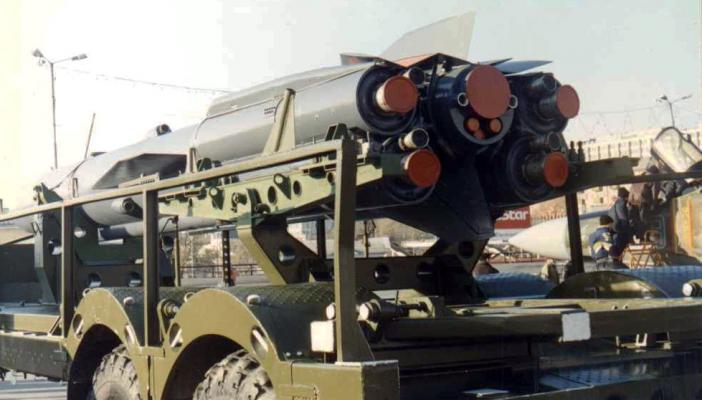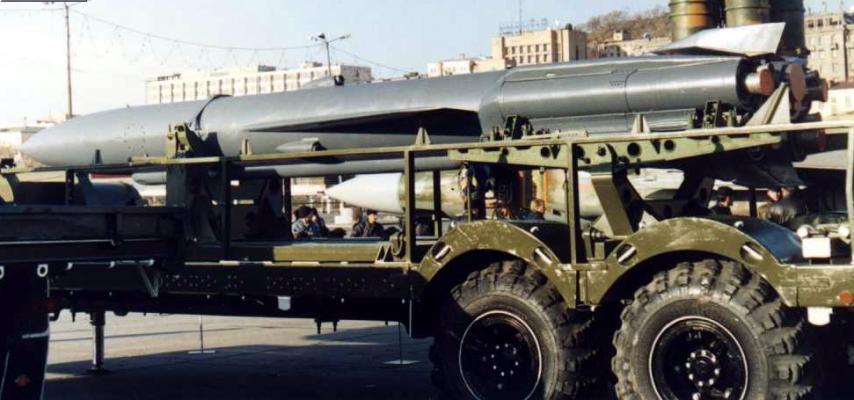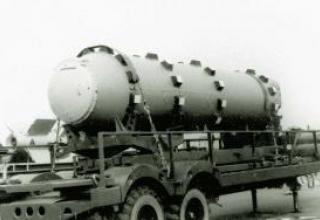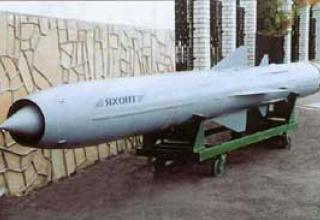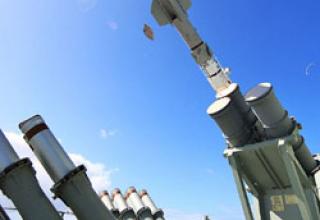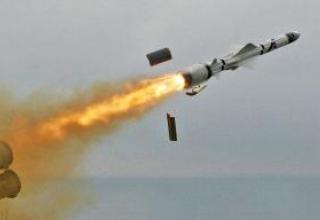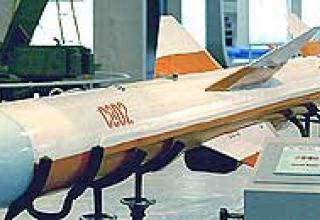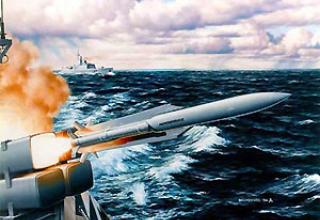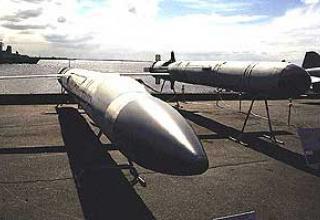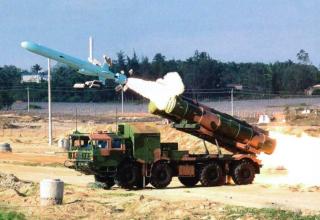On April 1, 1959 was issued the Decree of the USSR CM № 363-170 to develop the world's first anti-ship cruise missile with underwater launch.
The composition of the developers were included:
- OKB-52 GKAT - missile head;
- KB-2 GKAT - assault and launch engines;
- NII-6 GKOT - fuel for engines and combat unit of conventional type;
- TsKB-34 (Chief Designer B.G. Bochkov) - launch facilities for submarines of projects 661 and 670;
- NII-49 (Chief Designer B.A. Mitrofanov) - missile control systems;
- NII-3 (Chief Designer N. N. Sviridov) - development of the Rubin hydroacoustic armament complex, which ensured the detection of surface ships and the issuance of target designation for Amethyst missiles.
The "Amethyst" design was completed in 1959. Stage of joint tests was held from March 1965 to September 1966 by the CM Decree of June 3, 1968 missile system "Amethyst" was adopted by the Navy, where the missile "Amethyst" received a secret index P-70 and unclassified - 4K66.
The first carrier of missiles "Amethyst" was to be a high-speed nuclear submarine project 661. Project 661 K-162 submarine was laid in Severodvinsk on December 28, 1963. However, the work on its completion and testing was delayed, and it went into service only on December 31, 1969. The submarine of project 661 was created for struggle against aircraft carrying connections of the enemy. Its long submarine travel speed was 37-38 knots, i.e. it was 5-7 knots faster than aircraft carriers and security ships. Ten "Amethyst" missiles were in containers placed in the bow of the submarine out of the strong hull, tilted to the horizon. Later on, 661 project boats were abandoned from serial construction, primarily due to the fact that to produce the entire ammunition required to produce 2 separate volleys, the interval between which was about three minutes, which dramatically reduced the effectiveness of the missile attack. The elimination of this shortcoming (release of all ten missiles in one salvo) led to the need to radically redesign the submarine's deterrence system at launch depth.
The next generation of submarines designed to fight aircraft carriers - Project 670A boats - were built faster. The lead submarine of the project 670A K-43 entered service in 1967. In total 10 boats of 670A project were built at Krasnoye Sormovo plant.
Composition:
The rocket armament of the 670th project PL - eight Amethyst rocket launchers - was located in container launchers SM-97, placed in the front of the ship outside the strong hull at an angle of 32.5° to the horizon. The standard ammo included two missiles equipped with nuclear warheads as well as six missiles with conventional warheads. The PKR could be fired by two four-rocket volleys from a depth of up to 30m at a boat speed of no more than 5.5 knots and sea disturbance of up to 5 points.
The "Amethyst" rocket (see the scheme) was made according to the normal aerodynamic scheme and had a folding wing (see photo1, photo2).
The launch was made from a submarine from a depth of up to 30 m from a container previously flooded with inlet water. The missile's wings were automatically opened under water immediately after leaving the container. Under water, four launch engines and submarine engines were triggered, and after the rocket came to the surface, four air trajectory launch engines were activated, followed by a marching engine (see photo of the nozzle block). The flight took place at an altitude of 50-60 m with subsonic speed, which made it difficult to intercept the missile by means of air defense of enemy ships. "Amethyst" was designed for two range modes: 40-60 km and 80 km. Short range allowed for target designation by means of the boat itself.
The missile was equipped with a 4G-66 high-explosive combined combat unit weighing about 1000 kg or a special combat unit.
The 293-P marching engine was powered by injection fuel, and 4 submarine starting engines, 4 air trajectory starting engines and 2 scrap engines were powered by conventional NMF-2 ballistic powder. The marshal engine had an original two-piece layout with three lateral beveled, semi-inflated nozzles. The weight of the LTS-2KM brand fuel was 1040 kg. When firing at a distance of 40-60 km, the marshal engine operated for about three minutes.
The control system "Tor" was developed by NII-49 of the Ministry of Shipbuilding Industry. "Amethyst had an autonomous onboard control system implemented on the principle "shot and forgotten".
The control system consisted of the following components:
- autopilot;
- a radio altimeter;
- analogue computer
- radar homing head.
The homing system itself selected a target from several detected targets based on the analysis of the energy characteristics of the signals reflected from the targets and geometric signs of target location in the received radar picture, such as the position of the aircraft carrier in the aircraft carrier warrant.
The launchers for Amethyst were designed by the CKB-34, among them:
- launcher SM-101 for a floating stand;
- the SM-107 launcher for the re-equipped pilot submarine of project 61ZA;
- the SM-97 launcher for the nuclear submarine of project 661;
- the SM-97A launcher for the nuclear submarine of project 670.
Production of launchers was carried out at the plant № 232 "Bolshevik".
Along with many advantages, the rocket "Amethyst" had disadvantages. First of all - a short range, as well as insufficient interference immunity and selectivity of the onboard control system. Besides, the rocket was not universal - it was launched only from a submarine and only in a submerged position.
Characteristics:
| Maximum range of fire, km | 80 |
| Flying speed, km/h. | 1160 |
| The marching altitude of the rocket flight, m | 60 |
| The length of the rocket, m | 7,0 |
| Hull diameter, m | 0.55 |
| Launch mass of the rocket, kg. | 2900 |
| Fighting unit | coarse-cumulative |
| Weight of ordinary BC, kg | 1000 |
| Trotile equivalent of nuclear BC, kt. | 200 |
Testing:
Flash tests were conducted in August-September 1960. The first stage of the flight and design tests included 10 launches from a flooded PSA stand in Balaklava. The first launch of the Amethyst cruise missile from underwater position was made on June 24, 1961. Two more launches were made by the end of the year. In 1963-1964 at the plant № 444 submarine S-229 was converted under the project 61ZAD in the carrier rocket "Amethyst". In July-December 1964 from the submarine S-229 launched 6 missiles, 3 of which had a direct hit on the target, and 2 launches were unsuccessful.
The phase of joint tests was held in the Black Sea on the submarine project 61ZA from March 1965 to September 1966. A total of 13 launches were made and the tests were "mostly successful". In October-November 1967, Amethyst flight tests were conducted in the Northern Fleet from project 670A submarine. A total of 10 launches were made. Of these, 2 were single launches, 2 by a two-missile volley and 1 by a four-missile volley.
The submarine K-43 was in the Indian Navy from January 1988 to 1991, having spent about a year in autonomous voyages. All training missile firing ended in a direct hit to the target. On January 5, 1991, the boat's lease expired. On 5 January 1991, the boat's lease expired. India worked hard to extend the lease and even purchase a boat of the same type. However, under U.S. pressure, the Russian leadership abandoned plans to sell nuclear-powered submarines.
Sources:
- В.П. Кузин, В.И.Никольский Военно-Морской Флот СССР 1945-1991. СПб, "Историческое Морское Общество". 1996
- А.Н. Гусев Подводные лодки с крылатыми ракетами . СПб, "Галея Принт". 2000
- А.Б.Широкорад "Оружие отечественного флота" , Минск, Харвест, 2001г.
- www.militaryphotos.net
- http://saidpvo.livejournal.com/

